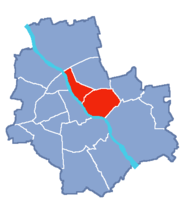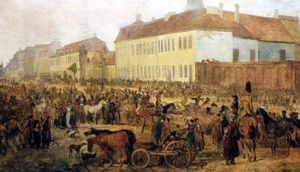
Praga
Encyclopedia


Warsaw
Warsaw is the capital and largest city of Poland. It is located on the Vistula River, roughly from the Baltic Sea and from the Carpathian Mountains. Its population in 2010 was estimated at 1,716,855 residents with a greater metropolitan area of 2,631,902 residents, making Warsaw the 10th most...
, the capital of Poland
Poland
Poland , officially the Republic of Poland , is a country in Central Europe bordered by Germany to the west; the Czech Republic and Slovakia to the south; Ukraine, Belarus and Lithuania to the east; and the Baltic Sea and Kaliningrad Oblast, a Russian exclave, to the north...
. It is located on the east bank of the river Vistula
Vistula
The Vistula is the longest and the most important river in Poland, at 1,047 km in length. The watershed area of the Vistula is , of which lies within Poland ....
. First mentioned in 1432, until 1791 it formed a separate town with its own city charter.
History
The historical Praga was a small settlement located at the eastern bank of the VistulaVistula
The Vistula is the longest and the most important river in Poland, at 1,047 km in length. The watershed area of the Vistula is , of which lies within Poland ....
river, directly opposite the towns of Old Warsaw
Warsaw
Warsaw is the capital and largest city of Poland. It is located on the Vistula River, roughly from the Baltic Sea and from the Carpathian Mountains. Its population in 2010 was estimated at 1,716,855 residents with a greater metropolitan area of 2,631,902 residents, making Warsaw the 10th most...
and Mariensztat
Mariensztat
Mariensztat is a neighbourhood in Warsaw's borough of Śródmieście . It is located between the Vistula river and the Old Town.The historical neighbourhood dates from the 18th century, when local nobleman Eustachy Potocki married Maria Kątska and received the parcel of land as part of Kątska's dowry...
, both being parts of Warsaw now. First mentioned in 1432, it derived its name from a Polish verb prażyć, meaning to burn or to roast, as it occupied a forested area that was burnt out to make place for the village. Separated from Warsaw by a wide river, it developed independently from the nearby city. Because of that, on February 10, 1648 king Władysław IV of Poland granted Praga with a city charter. However, as it was mostly a suburb and most buildings were wooden, the town had repeatedly been destroyed by fires, floods and foreign armies. Currently the only surviving historical monument from that epoch is the Church of Our Lady of Loreto
Church of Our Lady of Loreto
The Church of Our Lady of Loreto is an ornate church in Praga, a district of Warsaw, Poland, on the east bank of the Vistula River. The church stands on Ratuszowa Street and is Praga’s oldest monument...
.
Although there were numerous attempts to build a permanent bridge across the river, none succeeded and Praga remained a separate entity well into 18th century. Communications between the capital and Praga was maintained by privately-run ferries and, in the winter, over the ice. Finally, in 1791, during the reign of Stanisław August Poniatowski, Praga was attached to Warsaw as its borough.
The Battle of Praga
Battle of Praga
The Battle of Praga or Battle of Warsaw of 1794 was a Russian assault of Praga, the easternmost suburb of Warsaw, during the Kościuszko Uprising in 1794. It was followed by a massacre of the civilian population of Praga.-Eve of the battle:After the Battle of Maciejowice General Tadeusz Kościuszko...
, or Battle of Warsaw of 1794, was a Russian assault during the Kościuszko Uprising
Kosciuszko Uprising
The Kościuszko Uprising was an uprising against Imperial Russia and the Kingdom of Prussia led by Tadeusz Kościuszko in Poland, Belarus and Lithuania in 1794...
in 1794. It was followed by a massacre in which over 20,000 inhabitants of the Praga district lost their lives.
Unlike the western parts of Warsaw, during the World War II
World War II
World War II, or the Second World War , was a global conflict lasting from 1939 to 1945, involving most of the world's nations—including all of the great powers—eventually forming two opposing military alliances: the Allies and the Axis...
Praga remained relatively untouched and in the period of reconstruction of the capital was home to many ministries and public facilities.
Because of the traditional separate status of Praga, there are two Catholic dioceses in Warsaw - Archdiocese of Warsaw with St. John's Cathedral
St. John's Cathedral
St. John's Cathedral, or Cathedral of St. John, or other variations on the name, with or without the suffix 'the Evangelist, may refer to:In Antigua:*St. John's Cathedral, St. John'sIn Australia:*St John's Cathedral, Brisbane...
and Diocese of Warsaw-Praga with St. Florian's Cathedral
St. Florian's Cathedral
St. Florian's Cathedral, more formally known as the Cathedral of St. Michael the Archangel and St. Florian the Martyr , is a Catholic church and historical landmark at ul. Floriańska 3 in eastern Warsaw. The 75-meter towers of St...
.
The district experienced a revival following the end of Communism in 1989, as young artists moved into many of the former factory buildings, drawing in crowds in search of something different from the old town.
Administrative division
Currently Praga is administratively divided into:- Praga Północ (Praga North)
- Praga Południe (Praga South)
Praga Południe and Praga Północ include neighborhoods of:
- Saska KępaSaska KepaSaska Kępa is a neighbourhood in Warsaw, Poland, currently part of Praga Południe district. It is a seat of Park Skaryszewski-History:In the 17th century one of areas of present Praga Południe was turned into a military camp...
- GrochówGrochówGrochów is a suburb of Warsaw, officially part of the borough of Praga Południe. Currently it is one of the most notable residential areas of right-bank Warsaw. It is heavily built up with blocks of flats. However, there are still many houses remembering the times from before the Second World War...
- Szmulowizna
- Gocław
- KamionekKamionekKamionek, a neighbourhood in Warsaw, located on the right bank of the Vistula River, formally a village, in 19th century with beginning of Industrial Revolution in this part of the Russian Empire, transformed in to textile industry center...
In the wider sense, all areas of Warsaw located on the right bank of Vistula are also known under the collective term of Praga. Besides historical Praga, they include:
- Białołęka
- RembertówRembertówRembertów is a district of the city of Warsaw, the capital of Poland. Between 1939 and 1957 Rembertów was a separate town, after which it was incorporated as part of the borough of Praga Południe. Between 1994 and 2002 it formed a separate commune of Warszawa-Rembertów...
- TargówekTargówekTargówek is a district in Warsaw, Poland located in the northern part of the city.It is divided into two parts: residential and industrial. About 30% of the district's area is covered by municipal parks, such as Lasek Bródnowski, Park Bródnowski and Park Wiecha in the eastern part of the district...
- WawerWawerWawer is one of the districts of Warsaw, located in the south-eastern part of the city. The Vistula river runs along its western border. Wawer became a district of Warsaw on October 27, 2002 .Wawer borders Praga Południe and Rembertów from the north, Wesoła from the east and Wilanów with Mokotów...
- Wesoła

